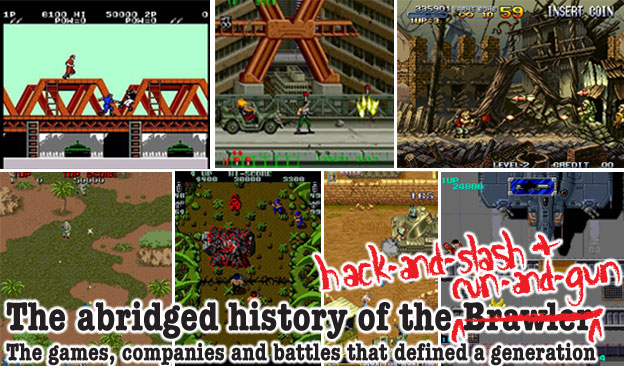
In 2005 Sony Santa Monica released the title God of War for the Playstation 2. The game was a phenomenal success. Earning accolades for the team and designer David Jaffe and his team made up of former Incog Inc. employees. The game was the culmination of the studio’s efforts and learning curve designing games outside of the mainstream. They first found success with Warhawk and Twisted Metal on the original Playstation. With the latter game they developed a dark cast that appealed to the maturing generation of game players. From War of the Monsters they learned combat systems and scaling combat between gigantic forces on the Playstation 2 hardware. From Downhill Domination they learned to create enormous environments and fantastic weather and particle effects. By the time Jaffe and company got to God of War they were well versed in hardware and software. What they did was develop an adventure which would be a response to the new breed of brawler from overseas.
The animations and control in God of War were amazing as Kratos, the hero, battled with unique weapons, the Blades of Chaos. The gameplay was not quite Dynasty Warriors and not quite Devil May Cry but somewhere in between. The hero was tough as nails, somebody that could have given Ken from Fist of the North Star a run for his money. In hand to hand or ranged combat the God of War lived up to his title. When Kratos was placed in breathtaking stages and puzzle environments that were as good as his dedicated fighting levels then the era of the single-player, Western produced, hack-and-slash had arrived.
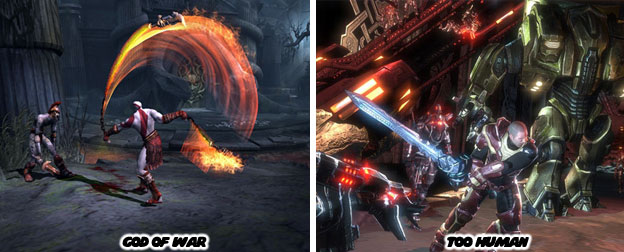
Other western developers were eager to answer the challenge that Sony had laid out Unfortunately Microsoft’s Too Human by Silicon Knights failed to impress players or critics. The camera, control, story and gameplay were all lacking. Even worse, it misunderstood the brawling roots that inspired God of War. The one-against-the-world design of God of War was instead few-against-many within Too Human. The 2008 title seemed to be trying to cash in on a trend without fully understanding how Sony Santa Monica had gotten there.
The best games in any genre were not developed out of thin air. Nor were they the results of following a trend. Every great title pulled the influences from the team and shaped them into a gaming experience. Often times all the creative minds needed was a spark of an idea and off they went. Treasure for example found greatness was once they stopped working on licensed games for Konami. The industry would follow the trendsetters and find that time and technology shaped every game differently. Look at how far the brawler went from its humble origins. Instead of Kung-Fu Master I could have chosen to follow an even older genre, the Cowboy Western for example.
In 1982 Taito had released a game called Wild Western. It, like the early run-and-gun games was not far removed from the space shooter titles or shoot-em-ups. Yet US developer Exidy developed a game just two years later called Cheyenne which was a light gun game. Already the western genre had become broad based on the tastes and influences of designers. Players were just along for the ride.
Capcom’s Gun Smoke from 1985 was not far removed from Commando. Players looked down on the hero from an overhead perspective as he cleaned up a western town. The important lesson here was that young players and future artists, designers and programmers were being influenced by these games, themes and heroes.
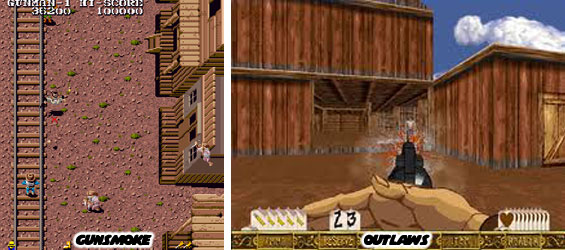
Outlaws was the first noteworthy FPS set in the wild west. The LucasArts title from 1997 predated Call of Juarez by years. It showed that a good story and emerging 3D technology could make for a great PC experience. The young developers that grew up on Japanese games were cutting their teeth programming PC titles like this.
Next to Konami’s Iron Horse, Express Raider was the oldest western brawler. Nihoun Bussan developed the game and Data East published it in 1986. The game was a precursor to Bad Dudes and every other great side scrolling brawler that the studio produced. Players could fight opponents on top of a moving train and even shoot at lawmen from horseback. The game was ahead of its time. Allowing gamers to act as criminals a decade before GTA was even conceived.
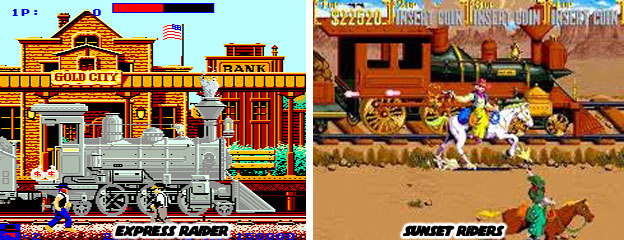
I had already talked about Konami’s Sunset Riders from 1991 so there would be no need to bring up the brawling gem again. It undoubtedly left its mark on arcade visitors.
Capcom’s version of Red Dead Revolver was coming along with a slightly silly tone before Rockstar finished the project and made it more serious for its 2004 debut. The new millennia seemed to mark a changing of the guard. Designers from North America and Europe were now passing up Japan in terms of the scope and design of projects. Players could perform all of the things they had seen in a limited capacity in earlier Japanese cowboy games, including fighting on top of moving trains or shooting from horseback. This time they could do it in glorious 3D.
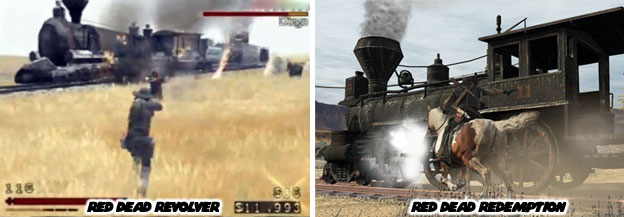
A few years later Rockstar developed a follow-up without the input from Capcom. The 2010 title Red Dead Redemption had shown how capable the US was at developing immersive playing experiences with a solid story, great controls and memorable designs as well.
What did Red Dead Redemption offer that none of the earlier console or arcade western titles could? It was the open world environment. Players were free to explore and interact with the world and make the game move along at their own pace. This sandbox environment would have meant nothing if players were unable to control the character easily. If they were not able to ride horses, have intuitive shoot outs or handle a surly stranger with the butt of a rifle, then players would have let the experience die. Rockstar had been building on the open game world through the Grand Theft Auto series and even The Warriors brawling games. They showed what was capable when players were allowed to experience a title at their own pace. As always if you enjoyed this blog and would like to sponsor me please visit my Patreon page and consider donating each month, even as little as $1 would help make better blogs and even podcasts!

Other western developers were eager to answer the challenge that Sony had laid out Unfortunately Microsoft’s Too Human by Silicon Knights failed to impress players or critics. The camera, control, story and gameplay were all lacking. Even worse, it misunderstood the brawling roots that inspired God of War. The one-against-the-world design of God of War was instead few-against-many within Too Human. The 2008 title seemed to be trying to cash in on a trend without fully understanding how Sony Santa Monica had gotten there.
The best games in any genre were not developed out of thin air. Nor were they the results of following a trend. Every great title pulled the influences from the team and shaped them into a gaming experience. Often times all the creative minds needed was a spark of an idea and off they went. Treasure for example found greatness was once they stopped working on licensed games for Konami. The industry would follow the trendsetters and find that time and technology shaped every game differently. Look at how far the brawler went from its humble origins. Instead of Kung-Fu Master I could have chosen to follow an even older genre, the Cowboy Western for example.
In 1982 Taito had released a game called Wild Western. It, like the early run-and-gun games was not far removed from the space shooter titles or shoot-em-ups. Yet US developer Exidy developed a game just two years later called Cheyenne which was a light gun game. Already the western genre had become broad based on the tastes and influences of designers. Players were just along for the ride.
Capcom’s Gun Smoke from 1985 was not far removed from Commando. Players looked down on the hero from an overhead perspective as he cleaned up a western town. The important lesson here was that young players and future artists, designers and programmers were being influenced by these games, themes and heroes.

Outlaws was the first noteworthy FPS set in the wild west. The LucasArts title from 1997 predated Call of Juarez by years. It showed that a good story and emerging 3D technology could make for a great PC experience. The young developers that grew up on Japanese games were cutting their teeth programming PC titles like this.
Next to Konami’s Iron Horse, Express Raider was the oldest western brawler. Nihoun Bussan developed the game and Data East published it in 1986. The game was a precursor to Bad Dudes and every other great side scrolling brawler that the studio produced. Players could fight opponents on top of a moving train and even shoot at lawmen from horseback. The game was ahead of its time. Allowing gamers to act as criminals a decade before GTA was even conceived.

I had already talked about Konami’s Sunset Riders from 1991 so there would be no need to bring up the brawling gem again. It undoubtedly left its mark on arcade visitors.
Capcom’s version of Red Dead Revolver was coming along with a slightly silly tone before Rockstar finished the project and made it more serious for its 2004 debut. The new millennia seemed to mark a changing of the guard. Designers from North America and Europe were now passing up Japan in terms of the scope and design of projects. Players could perform all of the things they had seen in a limited capacity in earlier Japanese cowboy games, including fighting on top of moving trains or shooting from horseback. This time they could do it in glorious 3D.

A few years later Rockstar developed a follow-up without the input from Capcom. The 2010 title Red Dead Redemption had shown how capable the US was at developing immersive playing experiences with a solid story, great controls and memorable designs as well.
What did Red Dead Redemption offer that none of the earlier console or arcade western titles could? It was the open world environment. Players were free to explore and interact with the world and make the game move along at their own pace. This sandbox environment would have meant nothing if players were unable to control the character easily. If they were not able to ride horses, have intuitive shoot outs or handle a surly stranger with the butt of a rifle, then players would have let the experience die. Rockstar had been building on the open game world through the Grand Theft Auto series and even The Warriors brawling games. They showed what was capable when players were allowed to experience a title at their own pace. As always if you enjoyed this blog and would like to sponsor me please visit my Patreon page and consider donating each month, even as little as $1 would help make better blogs and even podcasts!

No comments:
Post a Comment